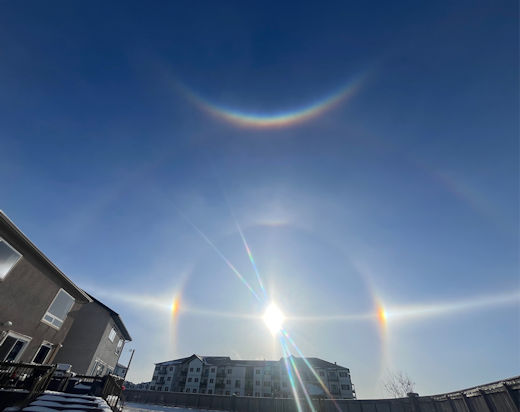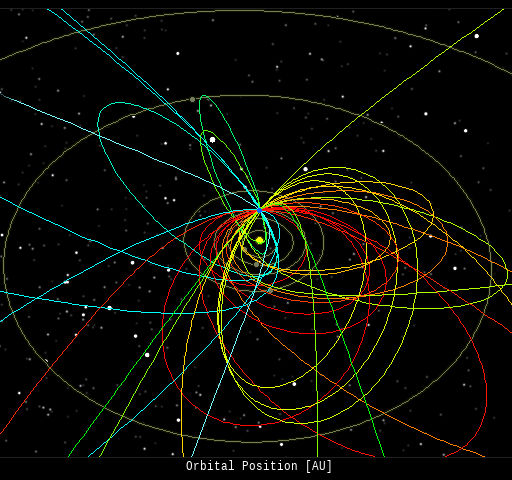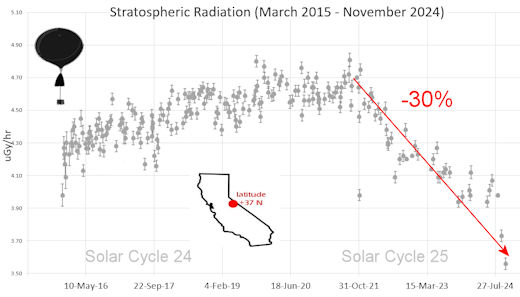 |
| |

SPACE WEATHER
NOAA Forecasts |
|
Updated at: 2025 Dec 24 2200 UTC
FLARE |
0-24
hr |
24-48
hr |
CLASS M |
30
% |
40
% |
CLASS X |
05
% |
05
% |
 Geomagnetic Storms:
Geomagnetic Storms:
Probabilities for significant
disturbances in Earth's magnetic field are given for three activity levels: active, minor
storm, severe
storm
Updated at: 2025 Dec 24 2200 UTC
Mid-latitudes
|
0-24
hr |
24-48
hr |
ACTIVE |
30
% |
15
% |
MINOR |
15
% |
05
% |
SEVERE |
01
% |
01
% |
High latitudes
|
0-24
hr |
24-48
hr |
ACTIVE |
10
% |
15
% |
MINOR |
25
% |
25
% |
SEVERE |
40
% |
25
% |
|
|
|
 |
|
|
|
| |
|
|
|
| |
This is an AI Free Zone: Text created by Large Language Models is spreading across the Internet. It's well-written, but frequently inaccurate. If you find a mistake on Spaceweather.com, rest assured it was made by a real human being.
|
|
|
ARCTIC AURORA WATCH: NOAA forecasters say that a CME launched on Dec. 20th might pass close to Earth on Dec. 24th. If it does, ripples in the solar wind could spark Arctic auroras on Christmas Eve. Travel tip: If you're flying on a high-latitude route this week, pick the window seat. Aurora alerts: SMS Text.
A SPECTACULAR HALO DISPLAY OVER CANADA: Bitter cold and diamond-dust ice crystals combined to produce an extraordinary sky show over Winnipeg, Manitoba, on Dec. 22nd. Photographer Marc Toews stepped outside into temperatures of -25C (-41C with windchill) and immediately noticed that this was no ordinary display.
"I’ve seen sundogs before," says Toews, "but today was something else."

His photo reveals a textbook collection of ice halos. On either side of the sun are bright sundogs, their rainbow colors sharply separated with red nearest the sun. A faint parhelic circle runs horizontally through the display, while high above the sun a circumzenithal arc forms a rainbow colored smile. A 22-degree halo, an upper tangent arc, and a supralateral arc complete the scene.
Complex displays like this are rare. All types of ice halos are caused by sunlight shining through ice crystals in the air. In extreme cold, especially during calm conditions, these crystals can become well aligned, allowing multiple halo types to appear at once. Winnipeg’s deep freeze provided ideal conditions.
Realtime Space Weather Photo Gallery
Free: Spaceweather.com Newsletter
CHRISTMAS GIFTS FROM THE STRATOSPHERE: Christmas is coming. Are you looking for a far-out gift? Check out the Earth to Sky Store. It's filled with items that have visited the edge of space onboard cosmic ray research balloons:

Earth to Sky gifts have flown above 99.7% of Earth's atmosphere, experiencing space-like blasts of cosmic rays, extreme cold, and a wild ride parachuting back to Earth after the balloon explodes. Even Amazon doesn't carry items this far out.
Don't forget to enter coupon code "BLACKCAT" at checkout for a 10% holiday discount.
Far Out Gifts: Earth to Sky Store
All sales support hands-on STEM education
Realtime Comet Photo Gallery
Free: Spaceweather.com Newsletter
Realtime Aurora Photo Gallery
Free: Spaceweather.com Newsletter
Every night, a network
of NASA
all-sky cameras scans the skies above the United
States for meteoritic fireballs. Automated software
maintained by NASA's Meteoroid Environment Office
calculates their orbits, velocity, penetration depth
in Earth's atmosphere and many other characteristics.
Daily results are presented here on Spaceweather.com.
On Dec. 23 2025, the network reported 18 fireballs.
(14 sporadics, 3 Ursids, 1 Dec. Leonis Minorid)

In this diagram of the inner solar system, all of the fireball orbits intersect at a single point--Earth. The orbits are color-coded by velocity, from slow (red) to fast (blue).
[Larger image] [movies]
Potentially Hazardous Asteroids ( PHAs)
are space rocks larger than approximately 100m that
can come closer to Earth than 0.05 AU. None of the
known PHAs is on a collision course with our planet,
although astronomers are finding new
ones all the time.
On December 25, 2025 there were 2349 potentially hazardous asteroids.
 |
Recent
& Upcoming Earth-asteroid encounters:
| Asteroid |
Date(UT) |
Miss Distance |
Velocity (km/s) |
Diameter (m) |
| 2025 YR4 |
2025-Dec-19 |
7.1 LD |
11.5 |
17 |
| 2025 YQ2 |
2025-Dec-19 |
0.7 LD |
6 |
4 |
| 2025 XV3 |
2025-Dec-19 |
14.7 LD |
15 |
53 |
| 2025 YA3 |
2025-Dec-19 |
2.4 LD |
24.5 |
19 |
| 2025 YB4 |
2025-Dec-19 |
2.4 LD |
16.6 |
6 |
| 2025 XQ3 |
2025-Dec-19 |
9 LD |
15.1 |
35 |
| 2025 YG1 |
2025-Dec-20 |
5.2 LD |
9.7 |
14 |
| 2025 XV1 |
2025-Dec-20 |
16.9 LD |
7.8 |
24 |
| 2010 WR7 |
2025-Dec-20 |
19.4 LD |
8.3 |
71 |
| 2025 XT4 |
2025-Dec-20 |
6.6 LD |
6 |
10 |
| 2025 YK4 |
2025-Dec-20 |
0.9 LD |
13.5 |
23 |
| 2025 XC4 |
2025-Dec-20 |
14.6 LD |
9.6 |
23 |
| 2025 XX4 |
2025-Dec-20 |
16.7 LD |
5.9 |
25 |
| 2025 YF |
2025-Dec-21 |
10.6 LD |
7.7 |
35 |
| 2025 YS3 |
2025-Dec-21 |
3.5 LD |
14.6 |
14 |
| 2025 XQ6 |
2025-Dec-21 |
11.4 LD |
11.6 |
44 |
| 2025 XH6 |
2025-Dec-21 |
6.4 LD |
13.4 |
14 |
| 2025 YD3 |
2025-Dec-21 |
1 LD |
8.3 |
7 |
| 2025 WT3 |
2025-Dec-22 |
16 LD |
4.5 |
26 |
| 2025 XT7 |
2025-Dec-22 |
10.3 LD |
7.6 |
14 |
| 2025 YH3 |
2025-Dec-22 |
1.2 LD |
10.1 |
10 |
| 2025 YU |
2025-Dec-22 |
15.1 LD |
8.8 |
24 |
| 2025 YC3 |
2025-Dec-22 |
9.7 LD |
12.3 |
88 |
| 2025 YE4 |
2025-Dec-22 |
14.2 LD |
14.4 |
19 |
| 2025 YY |
2025-Dec-23 |
2.6 LD |
11.9 |
28 |
| 2025 YJ3 |
2025-Dec-23 |
10.4 LD |
17.6 |
96 |
| 2025 YR2 |
2025-Dec-23 |
19.4 LD |
7.7 |
28 |
| 2025 YO3 |
2025-Dec-24 |
10.8 LD |
7.6 |
17 |
| 2025 YV3 |
2025-Dec-24 |
9.1 LD |
11.6 |
27 |
| 2025 YZ2 |
2025-Dec-24 |
8.6 LD |
10.8 |
23 |
| 2025 XN5 |
2025-Dec-25 |
11.3 LD |
15.5 |
51 |
| 2025 YY4 |
2025-Dec-25 |
8 LD |
18.6 |
34 |
| 2025 YD4 |
2025-Dec-25 |
3.6 LD |
20 |
54 |
| 2025 XP3 |
2025-Dec-26 |
13.3 LD |
13.5 |
55 |
| 2025 YS4 |
2025-Dec-26 |
9.8 LD |
20.1 |
29 |
| 2025 YP4 |
2025-Dec-26 |
14.1 LD |
7 |
17 |
| 2025 YA5 |
2025-Dec-27 |
9.9 LD |
10.6 |
22 |
| 2025 XJ4 |
2025-Dec-27 |
14.4 LD |
6.7 |
37 |
| 2025 YJ |
2025-Dec-28 |
18.7 LD |
7.4 |
19 |
| 2025 YW4 |
2025-Dec-28 |
2.9 LD |
7.4 |
28 |
| 2021 AB1 |
2025-Dec-28 |
10.2 LD |
12.3 |
16 |
| 2025 YZ4 |
2025-Dec-30 |
7.8 LD |
9.8 |
37 |
| 2019 AU |
2025-Dec-30 |
19.3 LD |
2.8 |
16 |
| 2024 AV2 |
2025-Dec-30 |
17.9 LD |
7 |
17 |
| 2025 YL4 |
2026-Jan-01 |
3.8 LD |
9.9 |
16 |
| 2025 XC7 |
2026-Jan-01 |
8.9 LD |
6.6 |
29 |
| 2025 YZ |
2026-Jan-02 |
14.1 LD |
6.7 |
29 |
| 2025 YT2 |
2026-Jan-02 |
14.9 LD |
5.5 |
10 |
| 2025 YF3 |
2026-Jan-03 |
15.4 LD |
7 |
35 |
| 2025 YF4 |
2026-Jan-03 |
12.6 LD |
7.3 |
21 |
| 2025 YA4 |
2026-Jan-04 |
13.1 LD |
15.6 |
39 |
| 2014 AF16 |
2026-Jan-04 |
9 LD |
9.6 |
34 |
| 2025 YY3 |
2026-Jan-05 |
18 LD |
13.2 |
31 |
| 2025 YV1 |
2026-Jan-05 |
11.9 LD |
16.5 |
53 |
| 2025 XS4 |
2026-Jan-06 |
8 LD |
6.5 |
24 |
| 2023 XM15 |
2026-Jan-07 |
15.2 LD |
6.9 |
51 |
| 2025 YL |
2026-Jan-12 |
7.7 LD |
3.9 |
13 |
| 2022 GR3 |
2026-Jan-12 |
14.5 LD |
12.9 |
9 |
| 2025 XN1 |
2026-Jan-14 |
9.3 LD |
4.7 |
36 |
| 2022 OB5 |
2026-Jan-14 |
1.7 LD |
2.2 |
6 |
| 2025 BL |
2026-Jan-17 |
4.7 LD |
6.9 |
28 |
| 2004 MO3 |
2026-Jan-17 |
17 LD |
10.2 |
129 |
| 2011 AM37 |
2026-Jan-17 |
19.8 LD |
5.1 |
4 |
| 2019 LZ4 |
2026-Jan-23 |
14.2 LD |
11.6 |
45 |
| 2025 YR1 |
2026-Jan-27 |
19.5 LD |
4.1 |
29 |
| 2022 AG |
2026-Jan-29 |
13.7 LD |
5.3 |
34 |
| 2020 GE |
2026-Jan-29 |
16.2 LD |
1.2 |
8 |
| 2023 RX1 |
2026-Jan-31 |
8.8 LD |
1.2 |
3 |
| 2022 OC3 |
2026-Jan-31 |
1.3 LD |
3.8 |
8 |
| 2021 CZ5 |
2026-Feb-09 |
18.3 LD |
9.3 |
23 |
| 2025 CC |
2026-Feb-09 |
17.6 LD |
5.1 |
11 |
| 2019 CN2 |
2026-Feb-11 |
20 LD |
9.2 |
7 |
| 2022 DV |
2026-Feb-12 |
15.4 LD |
5 |
18 |
| 1999 AO10 |
2026-Feb-13 |
10.5 LD |
2.7 |
59 |
| 162882 |
2026-Feb-14 |
17 LD |
19.2 |
626 |
| 2023 CM2 |
2026-Feb-21 |
4.2 LD |
11.4 |
22 |
| 2025 DQ |
2026-Feb-21 |
3 LD |
6.8 |
4 |
| 2007 DB61 |
2026-Feb-21 |
9 LD |
8.8 |
65 |
Notes: LD means
"Lunar Distance." 1 LD = 384,401 km, the distance
between Earth and the Moon. 1 LD also equals 0.00256
AU.
| |
Cosmic Rays in the Atmosphere |
SPACE WEATHER BALLOON DATA: Almost once a week, Spaceweather.com and the students of Earth to Sky Calculus fly space weather balloons to the stratosphere over California. These balloons are equipped with sensors that detect secondary cosmic rays, a form of radiation from space that can penetrate all the way down to Earth's surface. Our monitoring program has been underway without interruption for 10 years, resulting in a unique dataset of in situ atmospheric measurements.
Latest results (Nov. 2024): Atmospheric radiation is sharply decreasing in 2024. Our latest measurements in November registered a 10-year low:

What's going on? Ironically, the radiation drop is caused by increasing solar activity. Solar Cycle 25 has roared to life faster than forecasters expected. The sun's strengthening and increasingly tangled magnetic field repels cosmic rays from deep space. In addition, solar coronal mass ejections (CMEs) sweep aside cosmic rays, causing sharp reductions called "Forbush Decreases." The two effects blend together to bring daily radiation levels down.
.Who cares? Cosmic rays are a surprisingly "down to Earth" form of space weather. They can alter the chemistry of the atmosphere, trigger lightning, and penetrate commercial airplanes. According to a study from the Harvard T.H. Chan school of public health, crews of aircraft have higher rates of cancer than the general population. The researchers listed cosmic rays, irregular sleep habits, and chemical contaminants as leading risk factors. A number of controversial studies (#1, #2, #3, #4) go even further, linking cosmic rays with cardiac arrhythmias and sudden cardiac death.
Technical notes: The radiation sensors onboard our helium balloons detect X-rays and gamma-rays in the energy range 10 keV to 20 MeV. These energies span the range of medical X-ray machines and airport security scanners.
Data points in the graph labeled "Stratospheric Radiation" correspond to the peak of the Regener-Pfotzer maximum, which lies about 67,000 feet above central California. When cosmic rays crash into Earth's atmosphere, they produce a spray of secondary particles that is most intense at the entrance to the stratosphere. Physicists Eric Regener and Georg Pfotzer discovered the maximum using balloons in the 1930s and it is what we are measuring today.
| |
The
official U.S. government space weather bureau |
| |
The
first place to look for information about sundogs,
pillars, rainbows and related phenomena. |
| |
Researchers
call it a "Hubble for the sun." SDO
is the most advanced solar observatory ever. |
| |
3D
views of the sun from NASA's Solar and Terrestrial
Relations Observatory |
| |
Realtime
and archival images of the Sun from SOHO. |
| |
information about sunspots based on the latest NOAA/USAF Active Region Summary |
| |
current counts of failed and deployed Starlink satellites from Jonathan's Space Page. See also, all satellite statistics. |
| |
Authoritative predictions of space junk and satellite re-entries |
| |
from
the NOAA Space Environment Center |
| |
fun to read, but should be taken with a grain of salt! Forecasts looking ahead more than a few days are often wrong. |
| |
from the NOAA Space Environment Center |
| |
the
underlying science of space weather |
 |
Got a chipped or cracked windshield that prevents you from seeing space weather events while driving? Get windshield replacement from SR Windows & Glass with free mobile auto glass service anywhere in the Phoenix area. |
| |
These links help Spaceweather.com stay online. Thank you to our supporters! |
|
|
| |
|
|
|
|
 |
|
 |

 |
©2021 Spaceweather.com. All rights reserved. This site is penned daily by Dr. Tony Phillips. |